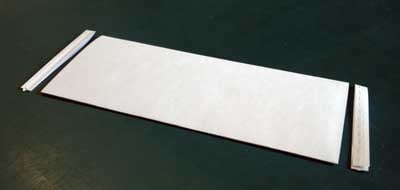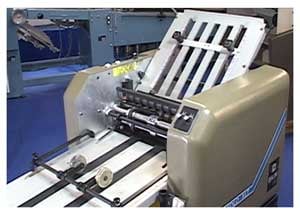Tabletop folding machines are typically used for simple folding jobs yet most of them have trimming tools available. You can use these to trim a job after it’s folded or to trim flat, unfolded sheets. If you don’t do a lot of trimming on your small folder, here are a few things to look out for to avoid problems and ensure good results.
 First, read the instruction manual so you understand and follow the recommended installation and setup procedure. Each machine has its own special requirements for trimming. Although most rotary trimming tools for these machines are very simple, there are a few small things that can cause big problems.
First, read the instruction manual so you understand and follow the recommended installation and setup procedure. Each machine has its own special requirements for trimming. Although most rotary trimming tools for these machines are very simple, there are a few small things that can cause big problems.
Here’s one example of what could go wrong. The slitter knives on Baum 714’s are mounted with screws. The screw holes are countersunk on one side and require a flat head screw. If you use the wrong kind of screw or mount the blade backwards (with the countersunk side against the knife collar), you will likely have problems with trimming.
Another feature of Baum, Challenge and similar folders is the blade installation which is a little different than what you find on the larger floor model folders. On larger folders you securely install  cutting knives on the holders first and then slide them on the shafts.
cutting knives on the holders first and then slide them on the shafts.
On smaller machines you have a two-step process. First you loosely mount the blade to the collar and slide the collar on the shafts. Then once they’re on the shaft you tighten the screws holding the knife to the collar. If you tighten the knives before sliding on the shafts, knife collars may not slide freely on the shafts. This in turn could interfere with your setup or even scratch the accessory shafts.
Always keep knives and counter knives clean. As a friend and mentor of mine used to say, “A clean machine is a happy machine!” It used to annoy the heck out of me whenever he pointed out some grunge on the press I was running, but he was right in his philosophy. If you have dirt on the back side of the blade, it will not lay flat when you attach it to the slitter blade holder. This will cause it to wobble ever so slightly which in turn prevents the knives from making consistent, smooth contact. The result is a fuzzy or ragged trim.
If you see visible damage to a cutting blade, such as a burr or a nick, either replace the blade or carefully try to repair it. If the burr or nick isn’t on the cutting edge of the blade, you might be able to file it or smooth it with emery cloth. Of course you want to carefully handle it so you don’t get cut. (We talk about using special gloves for handling sharp knives and perforator blades in this related article.) When in doubt, use a new blade.
Make sure there is no sideways play in the shafts. If one shaft or both shafts are moving, your trim will move too. Also, if the shafts are bent or bouncing up and down, it’s time for some maintenance and/or replacement.
Make sure your fold is accurate and consistent. Whenever you troubleshoot a trimming problem, always check the fold. Make sure it’s 100% accurate and remember the old garbage-in garbage-out rule. Once the fold is good you can continue on with your troubleshooting efforts if the problem still remains. If your machine can’t deliver an acceptable fold, then have a mechanic take a look and fix it.
Use center-trim or edge-trim deflectors as needed and supplied by the manufacturer. You might find that these have to be adjusted and re-positioned to get them to work correctly. A poorly positioned deflector will cause problems with trimming. Once you get the right setup though, you can usually repeat the setup process quickly.
Make sure the gripper rollers (pull out wheels) are in good condition. They should be clean and all of them should be in about the same condition. A poor or uneven grip can cause problems with rotary cutting.
If you have any tips or stories about trimming on small folders, please feel free to share them below!


